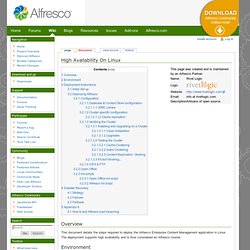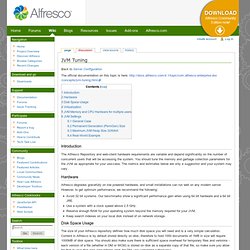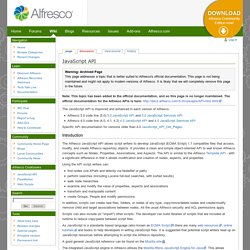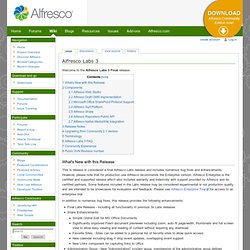

High Availability On Linux - AlfrescoWiki. This document details the steps required to deploy the Alfresco Enterprise Content Management application in Linux.

The deployment supports high availability and is thus considered an Alfresco cluster. For the purposes of this document the Alfresco deployment is comprised of two servers running RedHat Ent Linux. The Alfresco applications are deployed in Tomcat 5 and use a PostgreSQL database. The Applications will be fronted by a load balancer that will distribute the user requests equally among the two Alfresco servers. The version of Alfresco that these instructions are written for is 2.1.1 Enterprise. Initial Set up To install Alfresco in Linux a few things must be done prior to unzipping the Alfresco bundle. JVM Tuning - AlfrescoWiki. Back to Server Configuration The official documentation on this topic is here: Introduction The Alfresco Repository and web-client hardware requirements are variable and depend significantly on the number of concurrent users that will be accessing the system.

You should tune the memory and garbage collection parameters for the JVM as appropriate for your use-case. The metrics and estimates below are only a suggestion and your system may vary . Hardware Alfresco degrades gracefully on low powered hardware, and small installations can run well on any modern server. Avoid 32 bit systems. Disk Space Usage The size of your Alfresco repository defines how much disk space you will need and is a very simple calculation. It is highly recommended that a server class machine with SCSI RAID disk array is used. Virtualization. Developer Guide. JavaScript API. Note: This topic has been added to the official documentation, and so this page is no longer maintained.

The official documentation for the Alfresco APIs is here: The JavaScript API is improved and enhanced in each version of Alfresco. Specific API documentation for versions older than 4.0 JavaScript_API_Old_Pages. The Alfresco JavaScript API allows script writers to develop JavaScript (ECMA Script) 1.7 compatible files that access, modify, and create Alfresco repository objects. It provides a clean and simple object-oriented API to well known Alfresco concepts such as Nodes, Properties, Associations, and Aspects. Using the API script writers can: find nodes (via XPath and directly via NodeRef or path) perform searches (including Lucene full-text searches, with sorted results) walk node hierarchies examine and modify the value of properties, aspects and associations transform and manipulate content create Groups, People and modify permissions. Labs 3. Welcome to the Alfresco Labs 3 Final release.

What's New with this Release This is release is considered a final Alfresco Labs release and includes numerous bug fixes and enhancements. However, please note that for production use Alfresco recommends the Enterprise version. Alfresco Enterprise is the certified and supported release which also includes warranty and indemnity with support provided by Alfresco and its certified partners.
Some features included in the Labs release may be considered experimental or not production quality and are intended to be showcases for evaluation and feedback. In addition to numerous bug fixes, this release provides the following enhancements: Components. Search. Introduction The examples on this page apply to the "lucene" query language when using the search API.
Alfresco FTS is compatible with most, if not all of the examples here, except quoting of "@" and ":" etc is not required. From Alfresco 3.4, Share exposes Alfresco FTS directly, and defines its own default macro that is usually used. However you can type in queries direct using the example here, remembering you are using Alfresco FTS. Main Page. Web Scripts. NOTE: This document describes features found in Alfresco v3 onwards (Older versions: v2) The official documentation for web scripts is here. Welcome to the Web Scripts WIKI, the home for all Web Script related documentation. Web Scripts FAQ Web Scripts allow you to: Build custom URI-identified and HTTP accessible Content Management Web Services Turn your Alfresco repository into a content management powered HTTP Server Easily access, manage, and cross-link your content via a tailored RESTful API You do not need tooling or Java knowledge. Background Alfresco Web Scripts (introduced in 2006) brought together the worlds of content repository and the web.
Traditional ECM Repository interfaces are APIs, a collection of programmer methods for interacting with the Repository. Web Scripts provide RESTful access to content held within your Alfresco Enterprise Content Repository. Since 2006, Web Scripts proved themselves exceedingly useful and have been used in all kinds of solutions: Web Scripts FAQ. Back to Web Scripts. Q: Are web scripts easy to use? A: Web scripts are activated with simple URL calls, You need some knowledge of JavaScript and FreeMarker templates. You do not need to know Java or .NET programming. (FreeMarker is a rendering engine that allows you to define rendering templates, and format the script outputs.)
The Web Script framework for constructing REST-style interfaces will simplify mashups. Web Scripts Examples. Back to Web Scripts. This page presents some sample Web Scripts that reside in your Alfresco Server at the folder: /Company Home/Data Dictionary/Web Scripts/org/alfresco/sample Quick start You can run some of these scripts right now on a clean install of Alfresco 2.1 or later. If you installed by following Installing on Microsoft Windows or Linux Quick Install then you can access the folder webscript here: Log in with the username admin and password admin. What Is All This Information?
For each Sample described below, you see the following information: